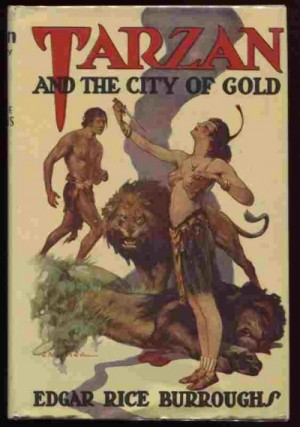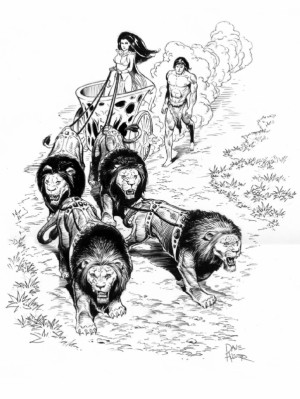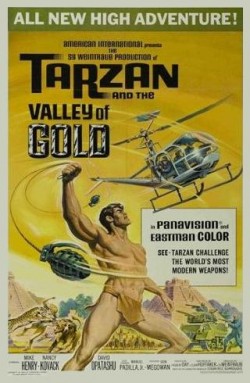 Tarzan and the City of Gold was originally published as a six part serial in the pages of Argosy All-Story Weekly
from 1932 to 1932 and is one of the quintessential Tarzan books. It has
lost cities, ferocious beasts, a beautiful queen, and Tarzan being
completely awesome. In the previous Tarzan stories we often found Tarzan
almost becoming a tertiary character, with whoever the current visitor
to the jungle becoming the central character, but in this book Tarzan is
not only the central character he actually reaches new levels of
coolness not achieved in the previous fifteen books.
Tarzan and the City of Gold was originally published as a six part serial in the pages of Argosy All-Story Weekly
from 1932 to 1932 and is one of the quintessential Tarzan books. It has
lost cities, ferocious beasts, a beautiful queen, and Tarzan being
completely awesome. In the previous Tarzan stories we often found Tarzan
almost becoming a tertiary character, with whoever the current visitor
to the jungle becoming the central character, but in this book Tarzan is
not only the central character he actually reaches new levels of
coolness not achieved in the previous fifteen books.While out hunting one day Tarzan is surprised by a group of shiftas (bandits and raiders) who immediately try and kill the ape man. Though greatly outnumbered by these armed and mounted bandits Tarzan is able to escape, killing a few of them in the process. Those bandits forgot jungle survival rule number one, do not screw with Tarzan of the Apes. Wanting to know what these raiders were up to, and maybe get a spot of revenge as well, Tarzan tracks down the shiftas. While watching the raider’s camp, looking for the most effective way to annoy or inconvenience them, he spots a most peculiar prisoner, a white man garbed in strange ivory apparel.
This moment gives us an interesting look into the psyche of Tarzan, “Ordinarily, Tarzan was no more concerned with the fate of a white man or by that of a black man or any other created thing to which he was not bound by ties of friendship; the life of a man meant less to Tarzan of the Apes than the life of an ape.” Tarzan decides to rescue the man, not because it is a fellow white man in need but because stealing this man away from the shiftas will be a nice revenge, but even more importantly the stranger's bizarre apparel has awakened Tarzan’s curiosity. Living in the jungle consists mostly of hunting for food, lying about in the sun, which is then broken up by the occasionally life or death struggle, but not a whole lot to stimulate the mind. Tarzan may have been raised by apes but it is man’s innate curiosity that drives him towards his greatest adventures.
So Tarzan rescues the man, hampered by a roar by a nearby lion that awakens the shiftas forcing Tarzan and the prisoner to fight their way out, but eventually the two win their freedom while adding a few more dead raiders to Tarzan’s tally. The stranger speaks no language that Tarzan can understand, which is unusual as Tarzan speaks about a dozen languages and dialects, but eventually he learns that the man is named Valthor and he is from Athne, the City of Ivory. Not one to pass up seeing another lost city Tarzan agrees to help Valthor find his way home; the poor guy has never left his valley and has horrible sense of direction, but unfortunately the way to Athne passes near Cathne, the City of Gold, and the mortal enemies of Athne.
Note: Burroughs not only loves lost civilizations but most of them consist of two warring factions. It’s cool for Tarzan to find a lost Roman outpost but even better if there are two Roman cities at war with each other. Strangely in Tarzan and the City of Gold we never make it to the aforementioned City of Ivory, eventually Tarzan will make it there in the book Tarzan the Magnificent, which in itself is an anomaly as Opar is the only other lost city that Tarzan ever revisits.
Tarzan and Valthor are caught in a terrible storm and while trying to cross a turbulent river a flash flood carries Tarzan away. The Ape Man is carried away down stream until eventually washing ashore far from his intended destination, and as Tarzan's life is often “Out of the frying pan and into the fire” he is soon captured by a group of Cathnean soldiers. He is accused of trying to break into the palace to assassinate the queen. Despite him not looking like your typical Athnean he is imprisoned to await whatever death sentence will amuse Queen Nemone. While waiting to find out the manner of his execution Tarzan must put up with a rather annoying cellmate; Phobeg, the strongest man in Cathne, who is to be punished for stepping on god’s tail. Turns out the people of Cathne worship lions, but not only do they have a lion for a god they use them for hunting and for pulling their chariots. At one point, when Tarzan is brought to the “Field of Lions” to meet his fate, he witnesses a chariot race consisting of such a combination, and if that doesn’t outdo anything we see in Ben Hur I don’t know what would.
What is incredibly fun about this section of the book is that Phobeg is an immense braggart but also fairly dense. The verbal games Tarzan engages with him here are simply hilarious; we don’t often get to see Tarzan’s dry sarcastic wit in these books and it is certainly a treat. What’s even better is that when Tarzan faces Phobeg in the arena, tossing this mountain of muscle around like a doll, he spares his life and gains a friend. This is another prime example of Tarzan’s code of killing; he kills for food and self-defense, certainly not for the amusement of others.
Of course the other key character in this book is the beautiful Queen Nemone, whose beauty even impresses Tarzan, but she is also kind of insane. Told that Tarzan was sent to kill her Nemone orders that the Ape Man be sent to the arena to die in mortal combat, but when he defeats Phobeg and refuses to kill the man, he starts to really have an effect on the Queen. Surrounded by yes-men and toadies this man who openly defies her awakens something inside her, certainly helped by the fact that he has the body of a jungle god. His first exchange with Queen Nemone, when he refuses to kneel to her, is another great example of Tarzan’s character, “Why should I kneel to you who they have said will have me killed?” demanded Tarzan. “Why should I kneel to you who are not my Queen? Why should I, Tarzan of the Apes, who kneels to no one, kneel to you?” Tarzan does not take shit from anyone. The threat of imminent death has no effect on Tarzan because he does not fear death. His lack of fear isn’t because he thinks he is invulnerable he just believes worrying about death, which comes to us all eventually, is a waste of energy and not very useful.
Needless to say Queen Nemone falls madly in love with Tarzan, and I must stress “madly” because she is a few fruit loops short of a box. She in fact may be the most beautiful woman in the world, but she also has any woman who comes close to reviling her beauty killed or maimed. She basically defines the word insecure, and this isn’t helped by the fact that her claim to the throne is dubious at best. Tarzan is able to resist her charms, though he admits to being almost hypnotized by her beauty, and this will of course land him in the hot seat again. It’s during the scenes between the mad love-smitten Nemone and the aloof noble Tarzan that I ask the question, “Where is Jane?” Since Tarzan the Terrible Jane has kind of fallen off the map; Burroughs clearly enjoys injecting a love story in his books and a married Tarzan certainly hampers that. Often Burroughs will include secondary characters to inject a little romance in these books; in this book Tarzan befriends a Cathean noble who is in love with a girl whose beauty is a threat to Nemone, but Tarzan himself is not allowed to mix it up with the ladies. Now going by the scenes with Tarzan and Nemone it is clear that though Tarzan may be married he is certainly not buried, as the pages just ooze sexual tension. Having failed to kill off Jane in Tarzan the Untamed I’m betting Burroughs wishes there was some way to grant Tarzan a divorce without making the Ape Man come across as a cad.
Tarzan and the City of Gold is one of the better Tarzan books as it really showcases not only Tarzan heroic prowess as a jungle adventurer but his moral code and character as well. He’s also allowed to show a greater sense of humor than is typical of these books. This story does borrow an element from Tarzan the Terrible; in that book that narrative would randomly switch to a lone figure trailing after Tarzan and Jane that was eventually revealed to have been there son Korak, and in this book we get cutaways to a lion that is seemingly tracking Tarzan who is revealed to be, as a surprise to no one, Jad-bal-ja, the Golden Lion. In both instances most readers will have figured out who the mysterious person or lion but in the case of Tarzan and the City of Gold Jad-bal-ja’s has a much more dramatic and thematic arrival than Tarzan’s kid did at the end of Tarzan the Terrible. Jad-bal-ja’s last minute rescues may not be anything new but it here it leads to a more startling ending, and all told is just a cherry on top of an already fantastic story.
Note: This book is not to be confused with the movie Tarzan and the Valley of Gold. Aside from there being a lost city and a friendly lion there is no comparison.





No comments:
Post a Comment